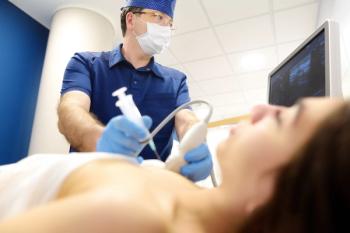
Oncology NEWS International
- Oncology NEWS International Vol 5 No 11
- Volume 5
- Issue 11
Analysis of Microvessel Density Predicts Extraprostatic Spread
HOUSTON-A new automated computerized system for analyzing the microvessel density of prostate tumors may help physicians more accurately stage the cancer before surgery, and thus assist physicians and patients in making treatment decisions, say Brian J. Miles, MD, of Baylor College of Medicine, and his colleagues at the Mayo Clinic, Washington University, Laval University, Quebec, University of Colorado, and Fred Hutchinson Cancer Research Center.
HOUSTONA new automated computerized system for analyzing the microvessel density of prostate tumors may help physicians more accurately stage the cancer before surgery, and thus assist physicians and patients in making treatment decisions, say Brian J. Miles, MD, of Baylor College of Medicine, and his colleagues at the Mayo Clinic, Washington University, Laval University, Quebec, University of Colorado, and Fred Hutchinson Cancer Research Center.
The technology, optimized microvessel density (OMVD) analysis, uses digital images of needle biopsy slides to measure the quantity of vessels feeding the tumor.
"Microvessel density is higher in cancer tissue from patients with extraprostatic extension than in those without extension beyond the prostate, and appears to be a significant predictor of final pathologic stage," says Dr. Miles, associate professor of urology.
An interim analysis of an ongoing US-Canadian multisite study showed that the technique, when combined with PSA results and Gleason score, significantly increased the ability to predict extrapros-tatic extension of the tumor preoperatively (Urology 48:47-57, 1996).
The study involved 186 previously untreated patients with clinically localized prostate cancer who underwent bilateral pelvic lymphadenectomy and radical prostatectomy. No patient had clinical evidence of extraprostatic extension or metastases prior to surgery.
The researchers retrospectively evaluated each needle biopsy sample showing cancer, to determine OMVD and Gleason score; serum PSA levels were determined preoperatively. Tumors were pathologically staged from the prostatectomy samples (62% organ-confined cancer and 38% with extraprostatic extension).
For each cancer field in the needle biopsy slides, the researchers obtained a vessel image, digitally enhanced to exaggerate the contrast between microvessels and tissue, and a tissue image, digitally enhanced to exaggerate the contrast between tissue and lumen space. The summed microvessel count (top figure) and total tissue area (bottom figure) for all fields in all biopsy cores of each specimen were combined to calculate OMVD.
The microvessel density results, Gleason scores, and PSA levels were all significant and independent predictors of extraprostatic extension, whereas patient age and clinical stage were not significant. When microvessel density was combined with Gleason score and PSA, the effect was additive, with significantly improved predictive value.
To allow more accurate therapeutic stratification of patients with prostate cancer, the researchers developed a table showing the probability of extraprostatic extension based on Gleason score (4 to 10), PSA (2 to 50 ng/mL), and OMVD (25 to 750).
For example, according to the table, a patient with a biopsy Gleason score of 7 and serum PSA of 8 has a 53% chance of extraprostatic extension; the addition of OMVD alters this risk--lowering it to 37% when OMVD is very low (25) and increasing it to 89% when OMVD is very high (750). Obviously, the higher the chance of extraprostatic extension, the less likely radical prostatectomy would be recommended. "The clinician needs to decide what probability cut point to use to manage patients," Dr. Miles says.
The optimized microvessel density analysis will be marketed as BioStage Tumor Assessment Service and offered to physicians and pathologists by Bard Diagnostic Sciences, Inc., Seattle.
Articles in this issue
about 29 years ago
Factor Analysis of New Symptom Scale in Breast Cancer Finds Six Clustersabout 29 years ago
AIDS Funding Increased for Fiscal '97about 29 years ago
'Cancer Rates and Risks' Availableabout 29 years ago
New Breast Cancer Patient Resource Is Availableabout 29 years ago
Short-Term Metronidazole not Linked to Cancerabout 29 years ago
Various Capitation Models Are Available for Oncology Networksabout 29 years ago
NCI Urges full Disclosure of Cigarette Contentsabout 29 years ago
Antifungal Resistance on the Increaseabout 29 years ago
Fentanyl Patch Useful Alternative in Cancer Pain PatientsNewsletter
Stay up to date on recent advances in the multidisciplinary approach to cancer.
































































































